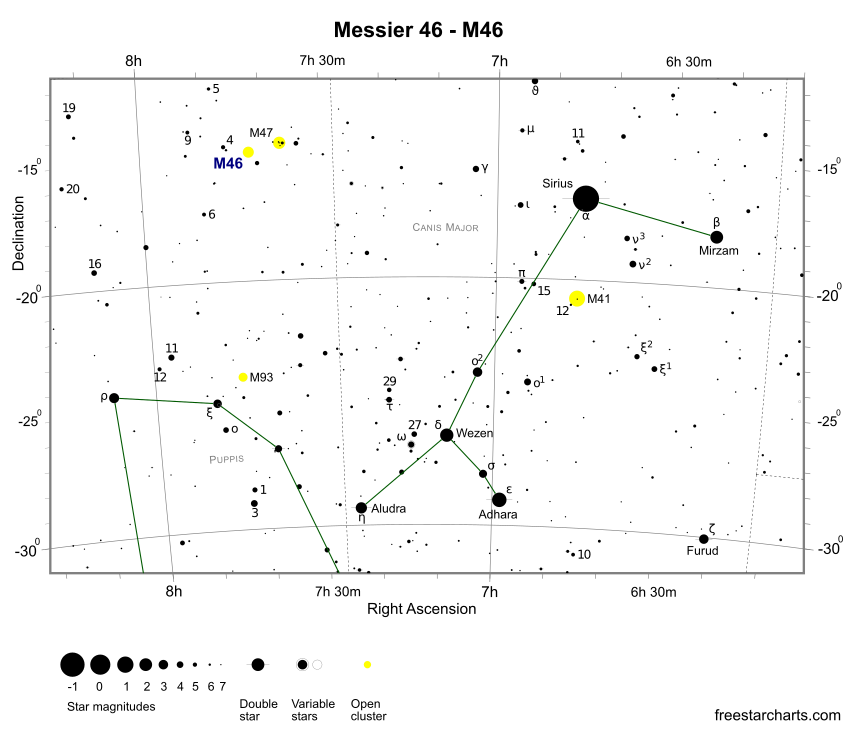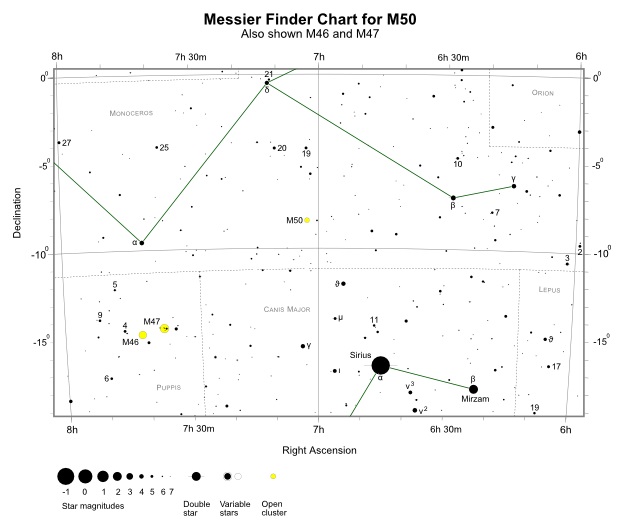M46 is a rich open cluster, easily visible with binoculars, that's located in the Milky Way star fields of the constellation of Puppis. The cluster is a relatively large object with an apparent diameter almost equal to that of the full Moon. It was discovered by Charles Messier on February 19, 1771 and is best seen from southern and equatorial latitudes during the months of December, January and February.
Puppis borders many constellations including Canis Major, the home of the brightest star in the sky, Sirius (mag. -1.46). To locate M46, imagine a line connecting Mirzam (mag. +1.98) with Sirius and extend it for 14 degrees in a north-easterly direction to arrive at the cluster. In addition to M46, there are two further Messier objects in Puppis, M47 and M93. All three are superb open clusters, with M47 positioned just over a degree northwest of M46. The third cluster M93 is located about 9 degrees south of the M46, M47 pair.


Finder Chart for M46 - pdf format (credit:- freestarcharts)

Finder Chart for M50 (also shown M46 and M47) - pdf format (credit:- freestarcharts)
With a magnitude of +6.1, M46 is on the fringe of naked eye visibility. When viewed through 10x50 binoculars, it appears mottled and more like a nebula than an open cluster. Also visible in the same field of view is the brighter, similar sized, but less richer cluster M47. About 0.5 degrees to the north of M47 is another open cluster NGC 2423 (7th magnitude). In larger 20x80 binoculars, the view of M46 is enhanced. The cluster appears large and dense with at least 50 fainter members visible. Through small telescopes, M46 looks like a sprinkling of stardust. An 80mm (3.1-inch) scope at high powers reveals many fainter stars of remarkably uniform brightness, especially when using averted vision. M46 is a superb sight through a 200mm (8-inch) instrument, with dozens of white and blue-white stars visible. At a magnification of about 100x, the field of view is completely filled with stars. In total, there are up to 150 stars brighter than mag. +13 with the brightest stars being of mag. +9. It's believed that M46 contains at least 250 stars.
One notable feature of M46 is a planetary nebula (NGC 2438), which is located at the northern edge of the cluster. It's visible in small telescopes of the order of 100mm (4-inch). The nebula appears as a diffuse circular patch embedded within the cluster, but is actually unrelated and therefore purely a line of site phenomena. It's estimated that M46 is 5,400 light-years distant, with the planetary closer at 3,000 light-years.
M46 has an estimated age of about 300 million years and a linear diameter of 30 light-years. It's a compact cluster with an apparent diameter of 27 arc minutes, almost the same as that of the full Moon. The cluster is a nice sight when viewed through all types of optical instruments. In the same wide field of view as M46 is M47, a brighter but less compact cluster. Also visible, is an unrelated planetary nebula (NGC 2438).
M46 Data Table
| Messier | 46 |
|---|---|
| NGC | 2437 |
| Object Type | Open Cluster |
| Constellation | Puppis |
| Distance (light-years) | 5,400 |
| Apparent Mag. | +6.1 |
| RA (J2000) | 07h 41m 47s |
| DEC (J2000) | -14d 48m 36s |
| Apparent Size (arc mins) | 27 x 27 |
| Radius (light-years) | 15 |
| Age (years) | 300 Million |
| Number of Stars | 250 |
| Other Name | Collinder 159 |